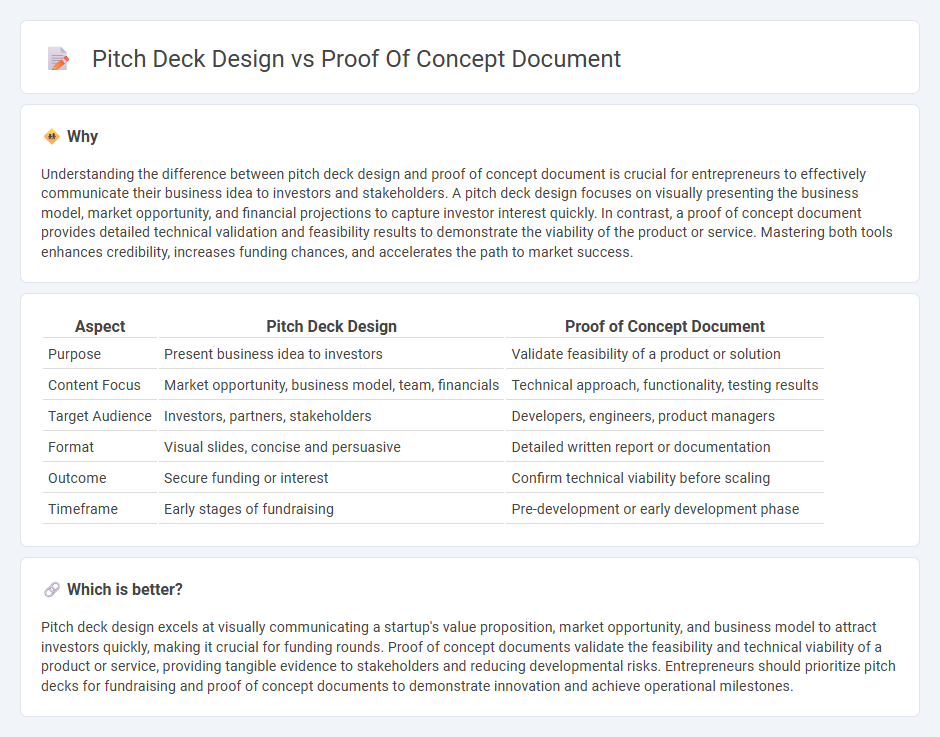
Pitch deck design focuses on visually engaging presentations that highlight key business ideas, market opportunities, and financial projections to attract investors and stakeholders. Proof of concept documents detail the feasibility and functionality of a product or service through prototype development, testing, and validation to demonstrate viability. Explore deeper insights to understand how both tools drive successful entrepreneurship strategies.
Why it is important
Understanding the difference between pitch deck design and proof of concept document is crucial for entrepreneurs to effectively communicate their business idea to investors and stakeholders. A pitch deck design focuses on visually presenting the business model, market opportunity, and financial projections to capture investor interest quickly. In contrast, a proof of concept document provides detailed technical validation and feasibility results to demonstrate the viability of the product or service. Mastering both tools enhances credibility, increases funding chances, and accelerates the path to market success.
Comparison Table
| Aspect | Pitch Deck Design | Proof of Concept Document |
|---|---|---|
| Purpose | Present business idea to investors | Validate feasibility of a product or solution |
| Content Focus | Market opportunity, business model, team, financials | Technical approach, functionality, testing results |
| Target Audience | Investors, partners, stakeholders | Developers, engineers, product managers |
| Format | Visual slides, concise and persuasive | Detailed written report or documentation |
| Outcome | Secure funding or interest | Confirm technical viability before scaling |
| Timeframe | Early stages of fundraising | Pre-development or early development phase |
Which is better?
Pitch deck design excels at visually communicating a startup's value proposition, market opportunity, and business model to attract investors quickly, making it crucial for funding rounds. Proof of concept documents validate the feasibility and technical viability of a product or service, providing tangible evidence to stakeholders and reducing developmental risks. Entrepreneurs should prioritize pitch decks for fundraising and proof of concept documents to demonstrate innovation and achieve operational milestones.
Connection
Pitch deck design visually communicates the core value proposition and business model, serving as a persuasive tool for investors, while the proof of concept document provides detailed validation of the product's feasibility and market potential. Together, they create a coherent narrative by combining compelling storytelling with evidence-based assurance, increasing credibility during funding rounds. This synergy enhances investor confidence, making the startup's vision and viability clear and convincing.
Key Terms
**Proof of Concept Document:**
A Proof of Concept (PoC) document details the technical feasibility and validation of a solution, emphasizing functionality, system architecture, and testing results. It serves as evidence that a concept can be developed into a viable product, targeting developers, engineers, and technical stakeholders with in-depth data and prototypes. Explore how a well-structured PoC document strengthens innovation efforts and facilitates informed decision-making.
Feasibility
A proof of concept document centers on demonstrating the feasibility of a project by detailing technical viability, potential challenges, and validation results to reassure stakeholders of successful implementation. A pitch deck design, while covering feasibility, emphasizes storytelling and visual appeal to engage investors and highlight market potential alongside the solution's practicality. Discover the best practices to effectively balance technical proof and persuasive design for project success.
Validation Metrics
A proof of concept (PoC) document centers on validation metrics such as viability, functionality, and technical feasibility, providing detailed data and test results to demonstrate a solution's potential. In contrast, a pitch deck design highlights key validation metrics like market demand, user engagement, and scalability through concise visuals and impactful narratives aimed at investors. Explore deeper strategies to effectively leverage validation metrics in both documents for stronger project endorsement.
Source and External Links
Free Proof-of-Concept Templates - A proof-of-concept template outlines key components such as defining the idea, identifying goals and resources, setting success criteria, and planning next steps to test feasibility and reduce risks early in the project lifecycle.
What is a proof of concept? [Examples + template] - A proof of concept documents the problem you're solving, target audience, required resources, and a clear plan to demonstrate that an idea is feasible before full development, often backed by data collected from potential users.
Your guide to proof of concept (POC) in product development - An effective proof of concept includes a problem statement, project definition, goals, and required resources to clarify the project's viability to stakeholders and guide the next steps.
 dowidth.com
dowidth.com